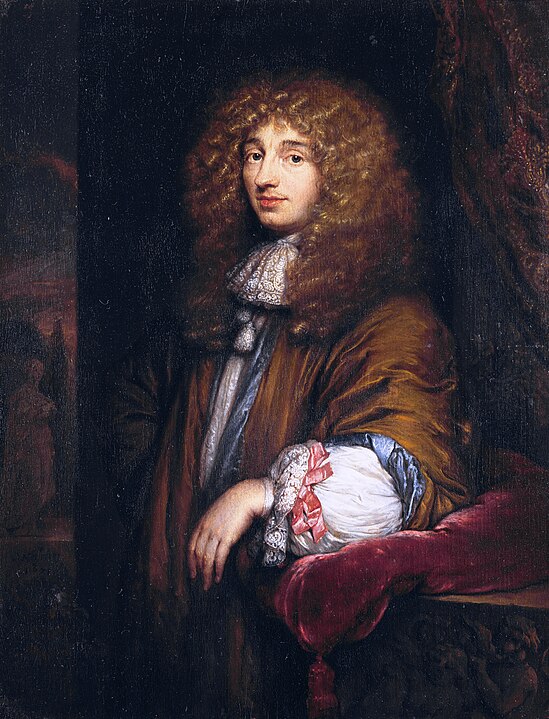
Christiaan Huygens was a mathematician, physicist, engineer, astronomer, and inventor. He was responsible for many discoveries during his lifetime. He discovered a new way to make more accurate telescope lenses by grinding and polishing them differently, and he used those lenses to find the first moon of Saturn, Titan, and to observe the true shape of the rings around Saturn. However, I am looking at him today because he was the inventor of the pendulum clock and the balance spring, which made clocks more accurate and furthered the scientific revolution and the Industrial Revolution.
People have tried to keep track of the time for thousands of years. Over 6,000 years ago, Ancient Egyptians used sticks in the ground as a rudimentary sundial. 3,500 years ago, they came up with a system of pots full of water with holes in them. The water dripped out of the pots at a calculated rate and markings on the pots showed the time. Candles were also used to tell the time. The speed a candle burns down can be roughly calculated and markings on the side of the candle can show the time.
The first mechanical clocks were invented in the 13th century by Christian monks in medieval Europe. Nobody knows who invented them, but there is mention of a mechanical clock on a church in Italy in 1309. Early clocks only had an hour hand, they usually chimed the hour, and they were usually installed on a building, such as a church. The English word “clock” comes from the Latin “clocca”, which means bell. The clocks worked using a heavy weight that descended at a controlled speed. The weight had to be lifted back up once a day and the clock reset. Most people reset the clock using the sun at noon, so most clocks would tell a slightly different time. These clocks were also not very accurate and could drift out of time by many minutes a day.
The average person had no need of a clock in Medieval Europe because they were farmers and they lived by the sun. However, as the Renaissance began, and the field of science started to grow, people realized that there was a need for a more accurate clock. The fields of astronomy and experimental science both need an accurate way of timing the movement of heavenly bodies or of basic scientific processes. And this is where Christiaan Huygens comes in.
In the 1580s, Galileo had discovered isochronism. That means that pendulums of the same length have the same period of oscillation. That means, if two pendulums are the same size, and one swings farther than the other one, they will both complete one swing in exactly the same amount of time. Galileo realized that this could be used for timekeeping and he tried to design a clock. His son started to make it after he died, but it was never finished.
Years later, Huygens was studying pendulums and he too realized that isochronism could be used to make an accurate clock. He spent some years designing it and had finished in 1656. He patented the design and had a working clock built by a clockmaker called Salomon Coster. His pendulum clocks were far more accurate than the existing mechanical clocks and they were accurate to within 15 seconds a day. He improved on his design over the years and brought that down to within 10 seconds a day. This reliability enabled astronomic and scientific discoveries that wouldn’t have been possible before. Newton used a pendulum clock when he was timing how long weights took to fall in the experiments for his theory of gravity.
Pendulum clocks are wonderfully accurate and they became the mainstay of clocks for the next 300 years, but they have their limitations. The pendulum can be affected by humidity, and it will not work on a ship. One of the biggest problems of the day was trying to calculate longitude. To do this, you needed to know the time where you were and the time at the place you had left from. That was only possible with an accurate clock on a ship. Pendulum clocks were accurate, but the pendulum couldn’t swing properly on a rocking ship. Huygens approached this problem, and he came up with the balance spring. The balance spring is a very thin spring that is tightened with the power from the clock’s mechanism and then springs back to move the time cog onwards. The time it takes for the spring to tighten and spring back can be set exactly to make the watch accurate. It is very similar to having a tiny pendulum inside a clock.
Now, it is argued that Christiaan Huygens didn’t invent the balance spring. A British physicist called Robert Hooke is said to have designed and built a clock with a balance spring 5 years earlier. That is probably true. It could be a case that Huygens heard of the invention and replicated it, or it could be a case of two people inventing a similar thing at the same time. That has happened a lot and can be explained by the way scientific discoveries progress. Still, Huygen’s invention is slightly different to Hooke’s and Huygens was able to build a working clock. Without his efforts, the evolution of the clock might have taken a lot longer.
More exact clocks enabled many of the scientific discoveries that sparked the Industrial Revolution. Many of the cogs and mechanical devices used in clocks were also used to make machines. The ability to tell the time exactly changed the way society thought as well. People went from living by the sun to living by the clock. Christiaan Huygens inventions changed society in many ways, for good and for bad. And this is what I learned today.
Image By Caspar Netscher – http://ressources2.techno.free.fr/informatique/sites/inventions/inventions.html, Public Domain, https://commons.wikimedia.org/w/index.php?curid=44047
Sources
https://www.worldhistory.org/article/2315/clocks-in-the-scientific-revolution/
https://en.wikipedia.org/wiki/Pendulum_clock
https://en.wikipedia.org/wiki/Christiaan_Huygens
https://www.aps.org/publications/apsnews/201706/history.cfm
https://www.hodinkee.com/watch101/isochronism
https://www.historyofinformation.com/detail.php?entryid=3506
https://museum.seiko.co.jp/en/knowledge/MechanicalTimepieces03/
https://akitajet.com/wiki/History_of_Clocks
https://www.govbergwatches.com/education/history-of-timepieces/
https://www.crownwatchblog.com/how-it-works/how-it-works-the-hairspring
